Ashton Gifford House
Ashton Gifford House is a Grade II listed country house in the hamlet of Ashton Gifford,[1] part of the civil parish of Codford in the English county of Wiltshire. The house was built during the early 19th century, following the precepts of Georgian architecture, and its estate eventually included all of the hamlet or tithing of Ashton Gifford. The house sits in the Wylye valley, part of the Cranborne Chase Area of Outstanding Natural Beauty.
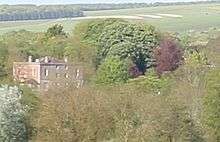
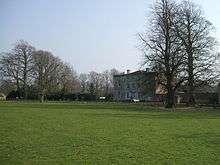
Early history
Ashton Gifford is recorded in the 1086 Domesday Book, listed as land belonging to Humphrey de l'Isle. The land was held by Robert, previously (under King Edward) having been held by Cynewig. Ashton Gifford was a relatively prosperous estate, valued at six pounds (from four pounds in 1066). The estate consisted of 12 acres (49,000 m2) of meadow, and pasture "6 furlongs long and as much broad".[2]
The site of the Anglo Saxon settlement can be seen in the field to the south of the current Ashton Gifford House, where different patches of colour in the earth indicate the sites of Anglo Saxon houses.
There is reference to the manor being known as Ashton Dunstanville in the late 14th century.[3]
The 1773 version of Andrews' and Dury's map of Wiltshire refers to Ashton Gifford as "Isherton".[4] The map shows around eleven houses forming the tything or hamlet of Ashton Gifford.[5]
Enclosure
An Act of Enclosure was passed for the "Tything of Ashton Gifford, in the Parish of Codford Saint Peter" on 27 May 1814.[6] This allowed for the enclosure of lands in the hamlet, naming William Hubbard Esq., William Hinton Esq., and Sarah Bingham, Spinster as the owners under the Lord of the Manor of Codford St Peter (Harry Biggs Esq.). Three "gentlemen" were appointed Commissioners for the enclosure: John Hayward of Rowde, John Rogers of Burcombe and Ambrose Patient of Corton. The Commissioners were instructed to meet at "a certain House called the George Inn in Codford Saint Peter aforesaid". The George still exists, as the George Hotel, in Codford High Street, though it was rebuilt in the later 19th century.
Construction
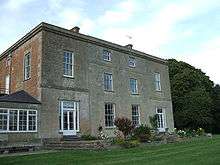
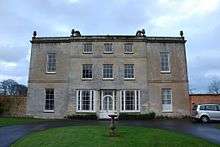
The main house appears to have been built in two principal stages. The central part, of three storeys, has thick walls which were constructed as external walls and which now lie in between the central portion and the east and west wings of the property. It is surmised that this part of the property was constructed some time around 1806 by Benjamin Rebbeck, a local landowner who had purchased the property (including around 93 acres (380,000 m2) of land) from the estate of the Earl of Shrewsbury.[7][8][9] Rebbeck lost the house to the mortgage holder in 1815 as a result of his spiralling debts, for which he was imprisoned in 1818, and the mortgage holder, William Hubbard, who is mentioned in the enclosure of Ashton Gifford, took possession of the house and added the two ashlar wings.[5] William Hubbard appears to have been resident by May 1817 (at the latest).[10] Hubbard also increased the size of the estate, to around 307 acres (1.24 km2).[8]
The walled garden, which appears to have been constructed around this time, and which is still a part of the property, lies to the west of the current house. It has been described as the largest in the county (at 1.3 acres).[11] It was in active use as a vegetable garden as recently as the 1980s, when the house was a school (see below).[12]
In the 19th century significant modifications to the property were undertaken. The owners added a service wing to the western side of the house, running from the original Georgian structure towards the walled garden. This wing contained the kitchens for the house (two in number), two dairies, pantries and store rooms, and servants' accommodation.[13] This wing was damaged by fire in the 1950s, and demolished in the early 1970s. The westernmost portion of the wing remains, and is now in use as garages.
The railway line linking Salisbury and Warminster, running to the south of the house, was opened on 30 June 1856[14] and Codford station close to the West Lodge (also known as Thatched Lodge or Station Lodge) provided rapid transport links for the Ashton Gifford Estate.[15]
Architecture
English Heritage, in their Images of England section[16] describe the property as having a limestone ashlar front with side walls of brick. The property is three-storied, with a three-window central block breaking forward and two-storey same-height side-bays. The main entrance is a distyle in antis Tuscan portico to the centre with inserted double half-glazed doors and flanking tripartite sashes, an inner main door with 6 fielded panels, fanlights and flanking margin-pane round-arched sashes with interlaced glazing bars. The ground floor of centre block has rusticated stonework. The first floor has three 9-pane sashes, and the second floor has a plat band and three 6-pane sashes. The two-storey side-bays have 8-pane margin sashes and a plat band. At the roof level there is a moulded cornice to the plain stone parapet with 20th-century pineapple decorations.
At the rear of the property there are two central bays which break forward with 12-pane sashes to ground floor, 9-pane to first and 6-pane sashes to second floor, side-bays have 8-pane margin sashes to ground and first floors. The interior features of the property that are highlighted by English Heritage include the central entrance hall with an oval open-well staircase (which has a continuous handrail and cast-iron balusters). Also noted are the presence of period doors, of six-panelled design, in panelled reveals and moulded architraves, and the existence of period window shutters. On the ground floor, the drawing room has a scrolled plaster ceiling margin and a fireplace, which are singled out for special mention.
Nineteenth century
William Hubbard, having completed the building of Ashton Gifford House (also known as Ashton House) sometime between 1815 and 1824, had occupied it by 1817[17][18] and remained in residence until his death in 1831.[19][20] One Henry Hubbard is recorded as having obtained a game licence at Ashton Gifford in 1817 and in 1825.[21] William Hubbard married three times. First, to Margaret Wilkinson in St.Petersburg by whom he had three children: Henry, Jane, and William. Second, to Grace Powditch (in London), by whom he had three further children: Grace, Susannah and Elizabeth. Third to Jane Turner Ingram, with whom he lived at Ashton Gifford; there were no children from this marriage. William's brother was John Hubbard, of Forest House, Leyton.[22][23] Around 10 of the old village houses were still standing in 1817, but these had been removed by 1839. The only original village building to be retained was a 17th-century cottage, which became the western (or Station) lodge house, now known as Ashton Cottage.[24]
After Hubbard died in 1831, the trustees of his estate sold the property in 1834 to James Raxworthy. The house was then sold to Wadham Locke in 1836, who at the time of the 1841 census was living at Ashton Gifford House with his wife Caroline and daughter Charlotte.[25] The estate at this stage amounted to some 364 acres (1.47 km2). In 1844 Locke married for a second time (Caroline having died in 1842).[26] His new wife, Albinia, was the daughter of the landowner John Dalton (of Keningford Hall, Yorkshire and Fillingham Castle, Lincolnshire).[27] Locke was formerly an officer in the first Dragoon Guards, and went on to become High Sheriff of Wiltshire in 1847[28] (he was occasionally described as being of "Ashton Giffard", the alternative spelling of the locale). He was a huntsman, purchasing a "famed" pack of foxhounds known as the Headington Harriers for "two seasons" from a Mr Jem Morrell, before selling them to Sir John Cam Hobhouse (later Lord Broughton).[29] An account of hare coursing on the Ashton Gifford estate is given in the Sporting Review of 1840.[30] Locke's father, also Wadham Locke (of Rowde Ford House),[31] had been High Sheriff in 1804 and was Member of Parliament for Devizes in 1832.[32] Wadham Locke I was the senior partner in the banking company of Locke, Hughes and Co of Devizes.[33] Wadham Locke II's youngest sister (Wadham Locke I's youngest daughter) became Frances Isabella Duberly, who achieved notoriety for her presence with the army at the front line of the Crimean War. After her mother's death in 1838, she had lived with her brother at Ashton Gifford, until her marriage in 1845.[34]
Wadham Locke paid for the construction of the village school at Codford St Peter, and subsequently supported it financially.[35]
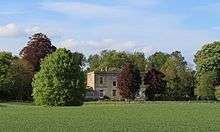
The Ravenhill family occupied Ashton Gifford House (sometimes known as Ashton House at this time) from 1850 until the 1870s.[5][36][37] John Ravenhill was a banker, the Chairman of the North Wiltshire Banking Company.[38] As a Warminster magistrate he had read the Riot Act at Hindon during the riots of 1830 (this was before he took possession of Ashton Gifford).[39] He served as the first Chairman of the Warminster Board of Guardians[40] and was commissioned as a Lieutenant in the 10th company, Wiltshire Volunteer Rifle Corps at the end of May 1860.[41] He was also a member of the Wiltshire Archaeological and Natural History Society.[42] John Ravenhill was Deputy Lieutenant of Wiltshire, and (in 1870) High Sheriff of Wiltshire. Ravenhill became friends with his neighbour Prince Leopold and Prince Leopold's wife the Duchess of Albany. The Duchess helped John Ravenhill's granddaughter Alice Ravenhill in her career.[43]
John Ravenhill's eldest son, John Richard Ravenhill (1824–1894) was an engineer in the firm of Miller, Ravenhill and Co (Richard Ravenhill, brother of John Ravenhill of Ashton Gifford, was a founding partner). The second son became Major General Philip Ravenhill who was the Commanding Royal Engineer in Gibraltar. The third son was the Reverend Canon Henry Everett Ravenhill (died 1913).[44][45] The fifth son, William Waldon Ravenhill, was a lawyer (called to the bar in April 1862).[46] The family were actively involved in the Codford St Peter School,[47] with John Ravenhill providing much of the funding.[48] An annual school fete took place, at which students from the "Sunday, National, and Night" schools were entertained (on the lawn, not in the house) and provided with tea and cake.[49] John Ravenhill died in 1878, apparently having moved out of the house to London some time before his death[50]
In the 1881 the house was occupied by George Clement, a race horse trainer,[51] along with his family. Clement had achieved the notable success of the "autumn double" in 1876, when his horse "Rosebery" won the Cambridgeshire and Cesarewitch Handicaps (the first of only three occasions when this has happened).[52][53] However Clement appears to have been a tenant of John Richard Ravenhill, the engineer and eldest son of John Ravenhill.
By 1882 the house was sold by John Richard Ravenhill to Thomas King Harding, a farmer, who occupied the house until his death in 1916.[54][55][56][57][58] The establishment was somewhat reduced under Harding. While the Ravenhills had run the house with six indoor servants (in addition to the gardening, coach and farm staff[59]), Harding had only three servants in the house.
In 1886 the head gardener at Ashton Gifford, William Henry Line, was charged with unlawfully destroying plants in the walled garden, and fined five pounds on being found guilty by the Warminster police court. A newspaper article of the trial gives a sense of the productivity of the walled garden: "Unripe cucumbers had been cut, the onion bed had been knocked about, fruit had been knocked off the trees and the trees pulled from the wall, strawberry plants pulled up and chrysanthemum plants in pots destroyed."[60]
Sale of 1920
The "Ashton Gifford Estate" was put up for sale by auction in 1920, on the "order of Captain H. N. Fane".[61][62] Rawlence and Squarey were the auctioneers, and the auction took place at the White Hart Hotel, Salisbury on 1 June.[63] Fane had purchased the property on the death of Harding in 1916 [57] The house was described at this time as having sixteen bedrooms and dressing rooms and the "usual offices". The dining room (now kitchen) and drawing room did not have the French doors to the south terrace that they currently have.[64] The estate included a bailiff's house, two lodges and two additional cottages and was described as "an attractive gentleman's residence.
The estate, of 60 acres (240,000 m2), included the home farm, which was described as "grass and meadowland, lying in a ring fence". The proximity of Codford station (on the Great Western Railway line) and the post and telegraph office are highlighted in the advertisement for sale.
From at least 1926 the house was occupied by Mrs Broughton Hawley.[65][66] In 1928 the house was bought by a local farmer, Mr Dowding (of Smallbrook Farm, Warminster) who had speculated in property in the past for £3,100. He sold at a loss.[67]
The 1930s and Lord Headley
By 1929 the house and land were auctioned by again, this time by Constable and Maude of London.[13] The agents had attempted to sell the property beforehand, offering the house and land at £4,500 before going to auction "at a low reserve".[68] The property was described as a "Residential and Sporting Estate", and at the time comprised 60 acres (240,000 m2) of park land. There was an ornamental lake, woodland, parkland and pasture, and a variety of estate buildings. The auction lot included stabling and garages (in the two former coach houses, which were advertised as accommodating up to six cars). There were also two lodge buildings: a main entrance lodge to the north east of the property (on the Codford High Street), and a "Station Lodge" with a thatched roof at the end of the south west drive, near the (now disused) Codford station. The station was in fact part of the Ashton Gifford hamlet, some way to the south of Codford.
The estate was advertised as possessing a wide range of farm buildings, and a bailiff's farm house. The bailiff's accommodation was substantial, with three reception rooms in addition to the kitchen.
Ashton Gifford House itself was described as having twelve bedrooms and dressing rooms – though there was only one bathroom servicing the main house (on the first floor) with a ground floor "Gentleman's W.C.". There were separate (outside) facilities for the servants. On the ground floor of the property, along with the "Gentleman's W.C.", there was an entrance hall, dining room, library, and two sitting rooms. At this time the external front door to the house was positioned in the most easterly of the three bays of the entrance portico. The doorway was subsequently repositioned in the central bay, restoring the symmetrical appearance of the front of the house. The Georgian portion of the house had, at this time, additional chimney stacks - two on the eastern and two on the western outer walls, servicing the upper floors of the property. These four stacks were removed later, and only the four central chimney stacks remain. The pineapple roof decoration had yet to be added at this stage, and the roof was pitched throughout (currently only the central part of the roof is pitched, with the east and west wings having flat roofs).
In 1930 and 1931 H. T. Guest was listed as resident at Ashton Gifford House.[69] The house was occupied from at least 1931 (until his death) by the Irish peer Lord Headley - Rowland Allanson-Winn, 5th Baron Headley.[70] Lord Headley is sometimes referred to as the first Muslim peer of Britain (a misnomer, as he was actually the second). He was President of the British Muslim Society, and died in 1935.[71] Lord Headley's widow (his third wife), Lady Catharine Headley (née Lovibond), continued living at Ashton Gifford House until 1940, when she shared the house with Greenways School.[72][73] Lady Headley opened the gardens to the public in aid of the Queen's Institute and district nursing under the National Gardens Scheme [74]
As a school
In 1940 Greenways Preparatory School was evacuated from Bognor Regis, Sussex to Ashton Gifford House, and the property became a school.[75] The poet Adrian Mitchell attending the school (which was run by Vivien Hancock, a friend of his mother) during the 1940s.[76] The poet Siegfried Sassoon's son, George, also attended Greenways in the mid-1940s. The school was a conveniently short distance from Heytesbury, where Sassoon lived. Siegried Sassoon was a close friend of Vivien Hancock (giving her a present of a horse when her own died). Sassoon's wife, Hester, accused Sassoon and Hancock of being "too close" in 1945, and Vivien Hancock eventually threatened legal action against her. Vivien's own son, Anthony, was killed (aged 21) in 1945 on the Western Front in France. When Vivien Hancock needed money to purchase the school outright, it was Sassoon who lent her the £8,000 she required (and who then waived the low rate of interest when Vivien Hancock had difficulty meeting it).[77] The politician and author Ferdinand Mount was briefly a student at Greenways in the 1950s.[78]
Around 1942 the British artist Keith Vaughan was stationed with the Royal Pioneer Corps in Codford, and painted "The Wall at Ashton Gifford" (now in the possession of Manchester Art Gallery).[79] The walled garden at Ashton Gifford were painted in "The Garden at Ashton Gifford" (1944) and "Tree felling at Ashton Gifford" (1942–43). Vaughan described the garden as an "oceanic surging of tangled nettles", with "waist high grass", the wall covered in a "jungle of weed and ivy".[80] Keith Vaughan's "The Working Party", drawn in 1942, has also been tentatively set at Ashton Gifford.[81]
There was a fire at Ashton Gifford House during the late 1940s which partially destroyed the Victorian era service wing of the property.[82] Vivien Hancock blamed this on an "electrical fault", though this has been disputed.[83] Greenaways School remained in possession until the late 1960s, when the school closed.
In 1969 planning permission was granted to Harrods Estate Offices to convert the house into three separate flats, which appears not to have been acted upon. By August of the same year the property was acquired by Mr. R. S. Ferrand, who renovated the house as a single-family dwelling.[84] The work was completed in 1972.[85] In the late 1970s the house was occupied by S Cardale.[86] In 1982, however, Ashton Gifford House became a school for boys with behavioural problems (trading as Ashton Gifford School in the 1980s). This finally closed in 1989, and ownership was transferred to a charitable trust.
Reversion to private dwelling
In 1992 Ashton Gifford House was sold, and planning permission was granted to convert it back to a private residence. The Codford by-pass (the A36 road) was built through the northernmost part of the property in the mid-1980s, shortening the drive.[87] (George Sassoon was to unsuccessfully fight a similar encroachment of his father's estate at Heytesbury). This required some of the agricultural land and woodland to be sold to the Department of Transport. The east drive for Ashton Gifford House now emerges onto Sherrington Lane, while the west drive continues its original link with Ashton Gifford Lane (prior to the breakup of the estate, Ashton Gifford Lane made up the complete length of the west drive, terminating at the Thatched or Station Lodge on Station Road). By 1992, all of the farm buildings and lodges had been sold as private dwellings, and the land associated with the house was reduced. The total land associated with the property is now some 20 acres (81,000 m2).
References
- grid reference ST961401
- Ashton Gifford in the Domesday Book
- "Wiltshire Archaeological and Natural History Society Journal" 1872, page 334
- "Codford map". wiltshire.gov.uk.
- "Codford: Wool and War in Wiltshire", John Chandler, Phillimore 2007"
- "An act for inclosing Lands in the Tything of Ashton Gifford, in the Parish of Codford Saint Peter, in the county of Wilts.
- The title of lord of the manor of Ashton Gifford was held by the earls of Shrewsbury until this sale in 1806, at which point the lordship dissipates
- ""Codford" page 41 "Ashton Gifford House and Park"".
- An R. Rebbeck, Esq. is listed as a subscriber to "The Works of the Rev. P. Doddridge" which was published in 1805. The address is given as "Ashton Gifford"
- Auction Catalogue of D&E Lake Limited, citing William Hubbard of Ashton House as provenance for a lot, as of 17 May 1817
- West Wiltshire District Council heritage
- Skyviews aerial photographs
- Auction brochure, Ashton Gifford House, Constable and Maude (of London), for a public auction held on 20 November 1929
- "Wilts, Somerset and Weymouth Railway, Salisbury and Winchester Journal, 28 June 1856, cited by Wiltshire OPC project at "Wiltshire OPC website".
- ""Codford" page 8, "The Railway and Station"".
- Historic England. "Details from listed building database (1181007)". National Heritage List for England. Retrieved 9 April 2007.
- D&L Lanes op cit
- Salisbury and Winchester Journal", 22 June 1818, listing supporters of Mr Benett who was standing for Parliament
- "Codford: Wool and War in Wiltshire", John Chandler, Phillimore 2007. However, William died in Crockerton in the nearby parish of Sutton Veny - probably Crockerton House, former residence of his friend Gregory Seale.
- William Hubbard was listed as living at Ashton Gifford in the Dorset Natural history and Archaeological Society proceedings of 1821
- Salisbury and Winchester Journal, Monday 27 October 1817, List (1) General Certificates at £3 13 6d each, and Monday 19 September 1825, List (1) General Certificates at £3 13 6d each
- Priscilla Alexander gr.gr.gr.granddaughter of William Hubbard and William Hubbard's will
- Visitation of England and Wales, College of Arms
- ""Codford" page 25 "Ashton Gifford"". Archived from the original on 31 December 2013. Retrieved 28 May 2019.
- 1841 UK Census
- Burkes Genealogical and Heraldic History of the Landed Gentry
- The Gentleman's Magazine 1844. Albinia was the fourth daughter of John Dalton. The marriage took place at Ripon
- The Jurist 1847
- "Drafts on my memory: Celebrities I have known", William Pitt Lennox
- The Sporting Review, edited by Craven, 1840
- "Book of the Lockes: A Genealogical and Historical Record of the Descendants of William Locke of Woburn", John Goodwin Locke, 1853
- "A Genealogical and Heraldic Dictionary of the Landed Gentry of Great Britain", Sir Bernard Burke
- "Twigg's corrected list of the country bankers of England and Wales", 1830
- "Mrs Duberly's War" edited by Christine Kelly
- Lewis's Topographical Dictionary of England 1845, cited by Wiltshire OPC project at "Wiltshire OPC website".
- 1841, 1851, 1861, 1871, 1881 UK census
- John Ravenhill listed in the Harrods Directory of 1865, cited by Wiltshire OPC project at "Wiltshire OPC website".
- 1871 census
- Daniell's History of Warminster, 2nd edition, 1879
- "The Unitarian and Foreign Religious Miscellany", vol 1, 1847 reports on a meeting that he had chaired
- Bulletins and other state intelligence for the year 1860
- "The Wiltshire Archaeological and Natural History Magazine", list of members 1862
- "Alice Ravenhill: Never say die" by Mary Leah de Zwart at "BC Booklook".
- "Visitations of England and Wales" 1909
- In 1866 he was vicar of Buckland Newton-cum-Plush in Dorset, and married Emma Harriet Everett, daughter of Joseph Everett of Greenhill House Wiltshire. Cited in The Gentelman's Magazine, May 1866, page 740
- "Men at the Bar: A biographical hand list of the members of the various inns" 1885. William Waldon Ravenhill married Anna Louise Everett of Greenhill House, Sutton Veny
- "Codford St. Peter School". Wiltshire Community History. Wiltshire Council. Retrieved 21 January 2017.
- "County Topographies: Wiltshire", ed E R Kelly, 1875"
- Salisbury and Wiltshire Journal, 1554 to 1558, cited by Wiltshire OPC project at "Wiltshire OPC website".
- "Wiltshire Archaeological and Natural History Society, Proceedings 1878"
- 1881 UK Census
- "horseracinghistory.co.uk".
- "first4winners.co.uk". Archived from the original on 20 December 2016. Retrieved 28 May 2019.
- "The Estates Gazette Digest of land and property cases"
- 1891 and 1901 UK Census
- Journal of the Bath and West and Southern Counties Society", 1913
- ""Codford" page 42".
- Kelly's Directory for the years 1889, 1895, 1903, 1907, 1911, 1915 cited by Wiltshire OPC project at "Wiltshire OPC website".
- A Thomas Coping is listed in the Kelly's Directory of 1903 as being bailiff to Thomas Harding, residing in Codford St Peter. He does not appear in subsequent directories. Cited by Wiltshire OPC project at "Wiltshire OPC website".
- "Extraordinary Conduct of a Gardener", Devizes and Wiltshire Gazette, 30 September 1886, cited by Wiltshire OPC project at "Wiltshire OPC website".
- The Fane family owned Boyton Manor in the neighbouring village of Boyton, not far from the south or station lodge of Ashton Gifford Estate. Boyton Manor was sold to the 9th Duke of Newcastle in the 1950s
- Kelly's Directory of 1920 does not give any owner of Ashton Gifford House, cited by Wiltshire OPC project at "Wiltshire OPC website".
- Country Life magazine supplement, 17 April 1920
- Visible in the picture accompanying the Country Life advert, ibid
- "Telephone Directories 1926, 1927, 1928".
- Kelly's Directory 1927, cited by Wiltshire OPC project at "Wiltshire OPC website".
- "Smallbrook Farm, Warminster, 1905–1965", Danny Howell, Wylye Valley Publications
- Country Life, 19 October 1929 page xxi, 26 October 1929 page xxi, 9 November 1929 page xxi, 16 November 1929 page xxi
- Telephone Directory held at ancestry.co.uk
- Who's Who, 1931
- "Lord Headley".
- "Lady's Who's Who" 1938. She also lived at 98 Portland Place, London W1
- "Dod's Peerage" 1942
- The Times, 1937 to 1939, cited by Wiltshire OPC project at "Wiltshire OPC website".
- "Greenways School, Codford". Wiltshire Community History. Wiltshire Council. Archived from the original on 7 May 2016. Retrieved 20 April 2016.
- "Passed/Failed: An education in the life of Adrian Mitchell, Shadow Poet Laureate" The Independent, 26 July 2007
- "Siegfried Sassoon: The Journey from the Trenches" J M Wilson
- "Cold Cream: My early Life and Other Mistakes", Ferdinand Mount, published Bloomsbury, 2008
- "The Wall at Ashton Gifford". Manchester Art Gallery. Retrieved 21 January 2017.
- osbornesamuel.com and Journal 62-63, 7 December 1975
- Bonhams "20th Century British Art" Catalogue, sale held 8 November 2008, lot 105
- Planning application to reconstruct the service wing, Wiltshire County Council, 1949
- Ferdinand Mount, ibid
- Wiltshire County Council planning application A/5773, and planning application A/6119/BR
- Commemorative stone on the south terrace of Ashton Gifford House
- "Telephone Directory 1976, 1977, 1978, 1979, 1980".
- "Correspondence, plans and papers in Codford A36 Bypass Enquiry". The National Archives. 1987. Retrieved 21 January 2017.